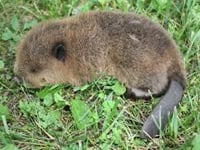

 |

|
 North American Beaver |
North American Beaver(Mammal) |
 North American Beaver Baby |
North American Beaver HabitsBeavers are found in streams and lakes in both remote and settled areas. Using their huge front teeth, they can fell very large trees and branches. They prefer oak, ash, elm, willow, poplar, and birch trees. They use them, together with mud, stones, and sticks, to construct dams across fast-flowing streams. The damming of streams causes the area behind the dam to flood, producing a large marsh rich in water plants, insects, birds, and fish. Within the dam, beavers construct lodges that have various underwater entrance tunnels. They excavate mud from portion of the marsh with their front paws, constructing a system of canals along with they travel to and from their feeding areas. They also push floating logs and tow sticks and branches down the waterways to new dam sites. Beavers use scent to mark their territories. They deposit anal secretions and a strong-smelling substance called castoreum on rocks and mud throughout their territories. Beavers warn each other of danger by slapping their tails violently on the water surface.
Much of the early exploration of North America was carried out by beaver trappers, who hunted the animals for their valuable fur. By the beginning of the twentieth century, the beaver population had declined dramatically. Careful planning that allows beavers to be harvested for their fur and meat now regulates its numbers. In the 1950s, before regulations were enforced, 6,000,000 beavers were killed in Canada. During the 1970s, after hunting was controlled, only 100,000 - 200.000 beavers were killed in the United States. |
North American Beaver CommunicationBeavers have few vocalizations. They rely primarily on subtle body postures and scent to communicate with other beavers. The kits, babies, are the most vocal. Whimpers and whines are their most common vocalizations, used to solicit attention and made when eating, grooming and playing.
Grunting, whistling, and nasal noises are made between colony members. Kits will make a loud whine when not getting their way. Grinding teeth is sometimes used as a warning. They will hiss and grunt before fighting or when frightened.
A tail slap is used to warn the colony of danger. The female uses this the most. Colony members will swim to deeper water at this signal. |
North American Beaver BreedingBeavers live in large, stable family groups consisting of one adult pair, their latest-born young, and the young born the previous year. Most beavers leave their family group at two years of age to find territories and mate.
Beavers pairs for life, and mating occurs during the winter. The kids are born in late spring in a chamber in the loge. They have full coats of fur and are able to swim within several hours of birth. They are nursed for 6 weeks, after which all members of the group share the task of bringing them food. They soon venture outside the lodge, but it will be many months before they can survive on their own. |
North American Beaver Food & FeedingBark is the beaver's staple food. To ensure a constant supply of food throughout the winter, the beaver spends a great deal of time in the fall felling trees. The beaver tows the logs along the canals it has made and stores them under water. Beaver do not hibernate in winter, but in the northern parts of their range they generally only leave their lodges to feed from stored food supplies. During this time, they live in constant darkness and lose track of time. Aquatic plants, thistles, meadowsweet, leaves, twigs, seeds, and roots make up most of the beaver's summer diet. |
North American Beaver Key Facts |
| Size |
| Height: Body: 24-32 inches long. Tail: 10-18 inches long. Shoulder height: 12-24 inches |
| Weight: 25-65 pounds |
| Breeding |
| Sexual maturity: 3 years |
| Mating: January-February |
| Gestation: 105 days |
| Number of young: Up to 8 kits |
| Lifestyle |
| Habit: Social, aquatic, mainly nocturnal. Builds dams, flooding large areas to provide habitat for itself |
| Diet: Mainly bark |
| Lifespan: 15-21 years |
DID YOU KNOW?
|
CAN'T FIND WHAT YOU'RE LOOKING FOR? CLICK HERE!!!